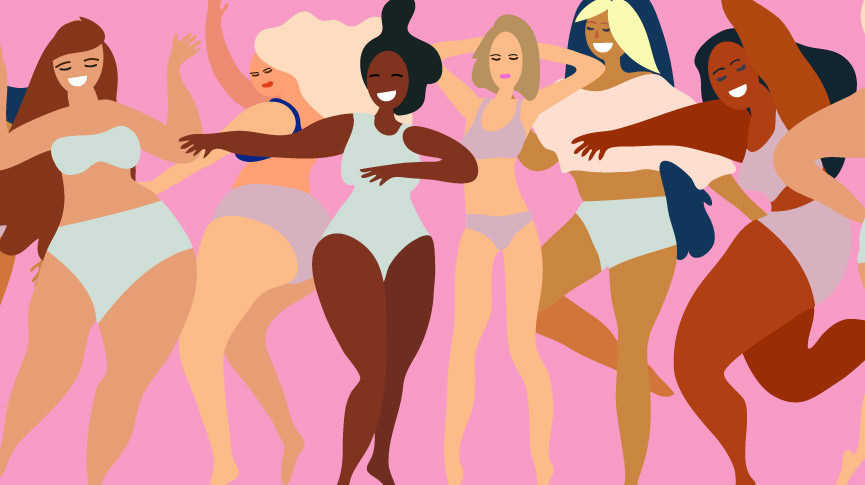Redefining Body Positivity

Although this should be mainstream understanding at this point, how someone’s body looks does not give any indication of their actual health.
Health goes beyond ripped abs and svelte calves. Health is a holistic term that encompasses someone’s body, mind, and spirit. Something that the body positive movement doesn’t always address.
Understanding Eurocentrism
As we are exposed to more representation from a wide variety of humans through social media and globalization, ideas like “body positivity” must evolve with it. You have to start somewhere, and that somewhere in terms of body positivity, is further evolved than past ideals and standards for beauty – but we still have a long way to go.
Most of these beauty standards are shaped by Eurocentric ideals. This is a harmful view that idealizes European culture and history, and ripples out into how we define acceptable body standards, making European features ideal, and “exoticizing” or shaming features that fall outside of those standards.
In the same way, European ideals have colonized much of the world, they also colonize our standards of beauty, and what is represented and celebrated in pop culture.
European features are not the epitome of beauty, and the racist undercurrents and practices that have unfolded from this idea need to be deconstructed and dissolved in order to move forward and change what it means to be body positive.
Let’s Celebrate it All
Even within body-positive campaigns and ads, many of these companies often miss the mark, and seem to only throw people in for what we like to call “diversity clout”.
The new meaning of body positivity goes beyond featuring a curvy body in an ad campaign, it’s celebrating the many differences and variations of humans that are possible. So yes, let’s embrace bodies of all different shapes and sizes.
Let’s decentralize away from Western standards of beauty, and not just feature BIPOC (Black, Indigenous, People of Color) in advertisements and campaigns to give the illusion of diversity, but also normalize the celebration of non-European features.
While we’re at it, let’s talk about celebrating…
- Gender inclusion. There is no one right way to be any gender. No matter how someone identifies in terms of their gender, anyway, they want to express that is beautiful.
- Hair, everywhere. From the hair on our heads to the hair on our toes, we’re constantly being bombarded with messages of how our hair should look and feel. No matter how you choose to wear your hair, how much or little you have – hair is just one of the tools we use to express ourselves and relate to our bodies.
- All abilities. Ableism is a form of prejudice against people with “disabilities” or different abilities than what is considered “normal”. Ableism also permeates into beauty standards. A holistic approach to body positivity encompasses the many range of abilities that is possible for humans.
- Pregnancy and Postpartum. Messaging around what someone’s body should or shouldn’t look like during and after pregnancy can be harmful, when really we should celebrate the fact that you just grew a human with your own body – not what you should look like after. Bodies change after pregnancy, it’s a part of life.
- Aging. Much like pregnancy, aging is a part of being human. These meat suits we live our lives in grow, shrink, shift, morph, wrinkle, and atrophy with time. How beautiful is it to witness these changes and the growing wisdom that comes with each forehead crease. The laugh lines that indicate a life well-lived. Now that’s beauty.
All this body positivity talk is nice in theory, but we also need practical tools as to how to embrace and love our bodies.
- Look for representation. Finding people who celebrate the traits that you are learning to accept gives you real-life examples of how to thrive in the body you call home. This is becoming easier and easier with social media.
- Become that representation. This isn’t for everyone, but some people find it incredibly healing to share their body positivity journey on social media. While no one is entitled to your story or your epiphanies, you may serve as a beacon of inspiration for your followers.
- Set boundaries. Are there certain people in your life or shows and media you consume that seem to wear on your self worth? We’re not saying to give these up, but if there are things or people in your life that become a constant source of comparison, it can be helpful to limit them by setting healthy boundaries.
- Do what makes you feel good. When prioritizing the health of your body, mind, and spirit, what’s the first thing that comes to mind? Is it eating a salad and pasta? Great. Is it dancing in your underwear? Awesome. Is it having sex with yourself or your partner? Amazing. Keep in mind the things that make you feel most at peace and at home in your body.
In the new era of body positivity, we’re here to celebrate all facets of the human experience and what it means to be in a body. This one goes out to every pimple, coarse hair, belly roll, injury, and scar – it all deserves to be embraced.

Natasha (she/her) is a full-spectrum doula and health+wellness copywriter. Her work focuses on deconstructing the shame, stigma, and barriers people carry around birth, sex, health, and beyond, to help people navigate through their lives with more education and empowerment. You can connect with Natasha on IG @natasha.s.weiss.


